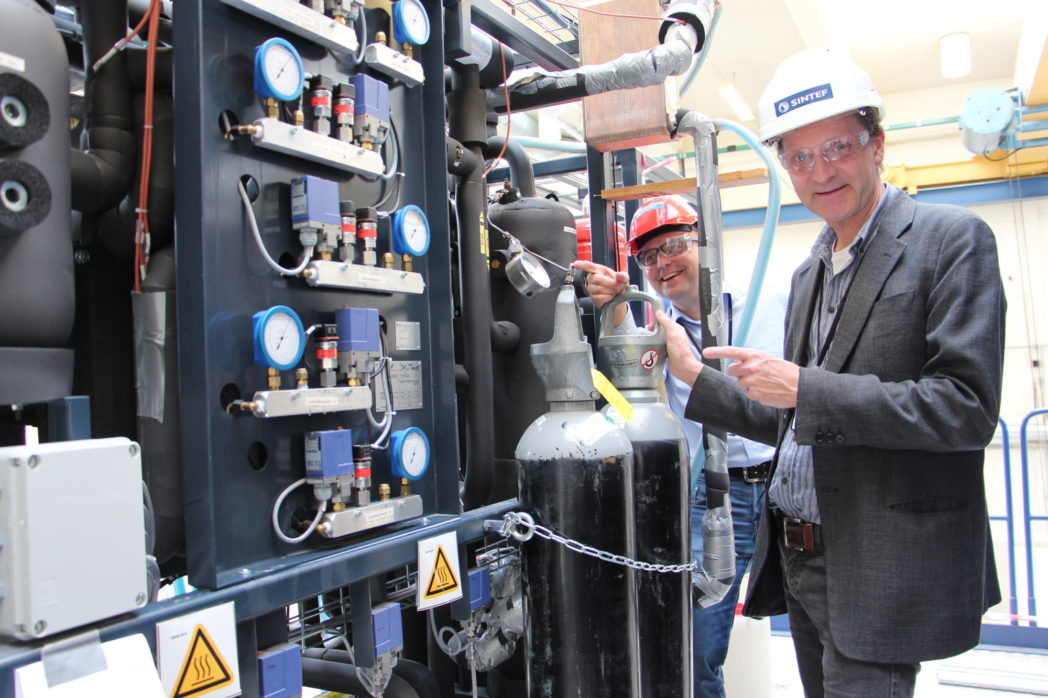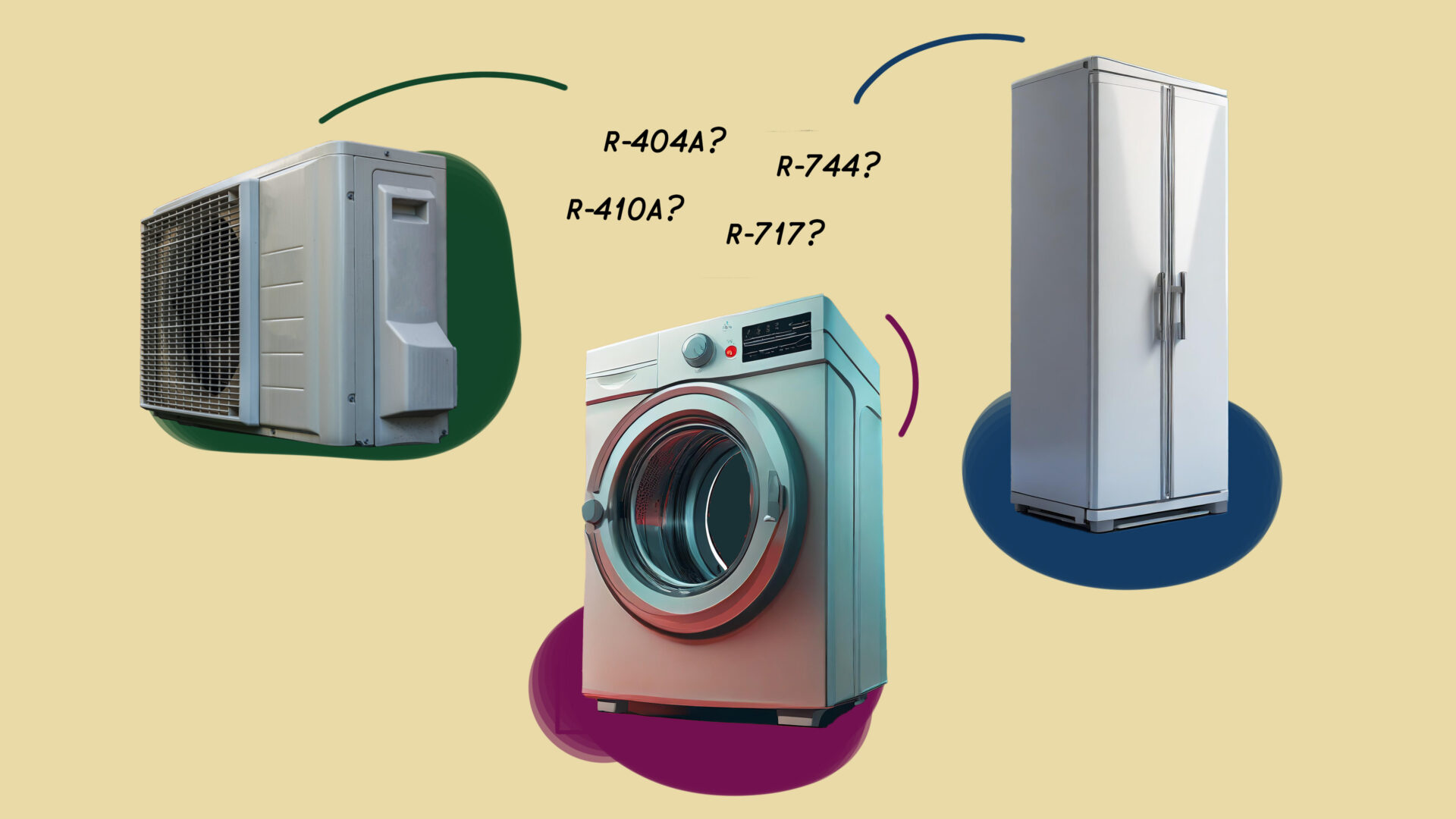Some refrigerants are better for the environment than others, but making the right choice is easier said than done for the average consumer. We took a look at the available options to try and simplify things a bit.
The problem with synthetic refrigerants
Synthetic refrigerants were in the crosshairs of environmentalists already in the mid-1980s, because of their destructive effects on the ozone layer. Chlorofluorocarbons (CFCs) are now banned for this reason. They were replaced by other fluorinated gases, which function well as refrigerants but have a high global warming potential.
What is a refrigerant?
Refrigerants are substances used in cooling systems and heat pumps. In short, they move heat around. Let’s look at how exactly that happens by taking a refrigerator as an example.
A refrigerant works by flowing through coils inside your refrigerator, and absorbing heat from the surrounding area in the process. As it absorbs heat, it changes from liquid to gas.
The gas then gets sucked into a compressor. The compressor increases the pressure of the gas, which also increases its temperature. Next, this high-pressure, hot gas flows through another set of coils or tubes, this time outside the refrigerator, and releases its heat. As it loses heat, it turns back into a liquid. The refrigerant is then returned to the inside of the refrigerator by the pressure difference, and the cycle starts over again.
The refrigerant known as R-410A, for example, found in many heat pumps used for household heating in Norway, has a global warming potential of around 2000. SINTEF Chief Scientist Petter Nekså, an expert in refrigerants, explains what this means: “R-410A having a global warming potential of 2000 means that if a kilo of that gas leaks into the atmosphere, it will contribute to warming 2000 times more than a kilo of CO₂, over a period of 100 years.”
Refrigerants are technically not meant to be released into the atmosphere, but in practice, this often ends up happening. Refrigerators and heat pumps age and malfunction, leaks occur, and the gases escape into the atmosphere.
Another issue with fluorinated gases leaking into the environment is that most of them belong to the so called PFAS (Per- and polyfluoroalkyl substances), and eventually break down into persistent components like TFA (trifluoroacetic acid). These substances persist in the environment and have been shown to accumulate in humans, causing various problems like cancer, thyroid disease, and low sperm count.
Natural refrigerants
Natural refrigerants, like their name suggests, are not synthetic, but occur naturally in the biosphere. They include ammonia, CO₂, hydrocarbons (such as propane or isobutane), and even such mundane substances as water and air. Ammonia, propane and isobutane have negligible global warming potential, whereas CO₂ has a global warming potential of 1.
They have no effect on the ozone layer, and they do not break down into persistent chemicals in the atmosphere.
That being said, natural refrigerants have their drawbacks as well. Ammonia is toxic, corrosive, and flammable when concentrated. Isobutane and propane are also flammable. These disadvantages are dealt with through careful engineering. Systems using ammonia, for example, are designed with materials that can withstand its corrosive effects. Household systems using isobutane and propane typically use a limited amount. “The maximum amount of isobutane or propane allowed as a refrigerant in household appliances is just 150 grams, says SINTEF Chief Scientist Petter Nekså. Even if a leak occurs, with such a small amount, the refrigerant will most likely be present at such a low concentration in the air that combustion will not be possible.”

What to get: refrigerator
The good news if you’re an environmentally conscious consumer on the lookout for a new refrigerator is that finding one that uses natural refrigerants is quite easy. The most widely available alternative in the case of household refrigerators and freezers is isobutane.
The reason for this is that since 2015, refrigerants with a global warming potential of 150 or more have been forbidden in new domestic refrigerators and freezers in Europe. The rule will likely be tightened in 2026 to forbid all fluorinated gases – with exceptions made for cases when they are needed to meet safety requirements.
Effectively, this means that most if not all household refrigerators and freezers sold from 2026 onwards will use natural refrigerants.
Checking the refrigerant before buying
Not all salespeople are aware of refrigerants, so it’s best not to rely on them entirely to get the information. A quick check on the websites of some large electronics retailers in Norway shows that the refrigerant used is often listed under the product specs (spesifikasjoner, in Norwegian). It is common to have to click on “specs” and then again on “show more specs” to get to the entry about the refrigerant.
Refrigerants are usually listed with a code starting with “R”.
Refrigerants are usually listed with a code starting with “R”. We listed some common ones in the table below. “R-600a”, for example, corresponds to isobutane, a natural refrigerant. In our experience, the specs published on the web mention the refrigerant type in about half of the cases. If the information is not listed under “specs”, check the product’s instruction manual: the refrigerant is sometimes specified there.
If you cannot find the information on the web, you need to physically examine the unit to find out (manufacturers are obligated by law to specify the refrigerant on the product itself).
A refrigerant cheat sheet |
||
| Refrigerant Code | Chemical Name or Composition | Global warming potential |
| R-404A | Mixture of Pentafluoroethane (R-125), Tetrafluoroethane (R-134a), and Trifluoromethane (R-143a) | ~3,922 |
| R-410A | Mixture of Difluoromethane (R-32) and Pentafluoroethane (R-125) | ~2,088 |
| R-22 | Chlorodifluoromethane (HCFC-22) | ~1,810 |
| R-407C | Mixture of Difluoromethane (R-32), Pentafluoroethane (R-125), and Tetrafluoroethane (R-134a) | ~1,774 |
| R-134a | Tetrafluoroethane | ~1,430 |
| R-32 | Difluoromethane | ~675 |
| R-290 | Propane | ~3 |
| R-600a | Isobutane | ~3 |
| R-744 | Carbon Dioxide (CO2) | 1 |
| R-717 | Ammonia | 0 |
Table: List of common refrigerants by code, name and global warming potential (GWP). A kilo of R-404A released into the atmosphere has double the global warming effect of driving an average European car for a whole year (assuming 108.2g CO₂/km, and a yearly driving distance of 18,000 km).
What to get: heat pump dryer
Many clothes dryers sold on the Norwegian market contain a heat pump. If you are in the market for one of those, your decision as an environmentally conscious consumer can really make a difference.
(…) your decision as an environmentally conscious consumer can really make a difference.
This is because the heat pump dryers (often called condensation dryers) we have found on the market use either R-134a (Tetrafluoroethane, with a global warming potential of over 1400) or R-290 (propane, with a global warming potential of zero).
Interestingly, the energy label of the appliance is not a good guide when it comes to choosing a climate-friendly refrigerant. One of the dryers we found using highly global warming R-134a had an energy label of A+++. This is because energy labels rate appliances based on their energy consumption, with no heed paid to the climate footprint of their refrigerants.
Again, the specs online do not always specify the refrigerant, and we sometimes had to dig through the user manual to find it, so do arm yourself with patience when looking for the information.
Clothes dryers fall under the “other self-contained heat pump equipment” category, for the purposes of EU regulations. In this category, greenhouse gases with a global warming potential of 150 or more are likely to be forbidden as of 2027 for new units. This means that units that are being sold today using R-134a will not be available at that time, whereas the ones using propane will.
What to get: air-to-air heat pump
Most household heat pumps used for domestic heating in Norway are air-to-air split systems. Air-to-air means they get their heat from the outside air and push it directly into the indoor air (as opposed to getting the heat from the ground, for example, and using it for a water born heating system). “Split system” means that the heat pump consists of two separate units: one outdoors and one indoors, with refrigerant circulating between the two.
For the purposes of this article, we have looked only at air-to-air split systems.
All the heat pumps of that type we found on the market, that specified the refrigerant used, were using R-32 (difluoromethane, with a global warming potential of 675). This GWP is about a third of that of the R-410A found in many earlier heat pumps sold in Norway – but it’s still a far cry from the GWP score of any of the natural refrigerants.
Nevertheless, if you’re looking to get a heat pump now, it appears that there is not much else than R-32 on the Norwegian market at the moment. Some propane units exist, where the full refrigerant circuit is located outside, only circulating a brine inside, but we were not able to find them in the product large online electronics dealers’ catalogues. This will change though, since current EU regulation roadmap suggests that R-32 will be forbidden for new units from 2029 onwards (as a fluorinated gas with a GWP of 150 or more). More propane options will likely be available by then.
The EU regulation roadmapIf you’re curious about upcoming EU refrigerant regulation, you can consult this document titled Regulation (EU) 2024/573 of the European Parliament and of the Council of 7 February 2024 on fluorinated greenhouse gases, amending Directive (EU) 2019/1937 and repealing Regulation (EU) No 517/2014. The rules we refer to in this article are derived from this 67-page legal document, which came into force just recently. |
Should I change my heat pump?
So, you checked your early 2000s heat pump and found out that it uses a refrigerant that has a very high global warming potential. What to do then? Should you change it? Not really, says Petter Nekså: “If your heat pump works properly, there is no need to change it. The important thing is to prevent leaks. You can do that by ensuring that it is properly maintained. The companies installing heat pumps can also carry out maintenance on them.”
If your heat pump works properly, there is no need to change it. The important thing is to prevent leaks.
Disposing of a refrigerator, condensation dryer or heat pump
When the day comes that you decide to get rid of your refrigerator, condensation dryer or heat pump, it’s very important to do it properly. Bring your appliance to a recycling centre or to the retailer who sold you the product initially. Crucially, make sure the appliance does not get damaged along the way. Refrigerators and freezers sometimes have tiny delicate tubing near the compressor, and damaging it will cause a leak.
Natural refrigerants in an industrial context
Natural refrigerants are on their way in factories and businesses as well. Norwegian grocery chain Rema 1000 has already adopted them at most of its locations. Some process industries and building applications are also working on new natural refrigerant-based heat pumps. The systems needed in these cases have specific requirements regarding temperature, size and security. The Research Centre FME HighEFF, led by SINTEF Energy Research, does work on natural refrigerants as part of its , and hosted the IIR Gustav Lorentzen conference on Natural Refrigerants in Trondheim, 2022.


0 comments on “Choosing Eco-Friendly Refrigerants for Appliances”